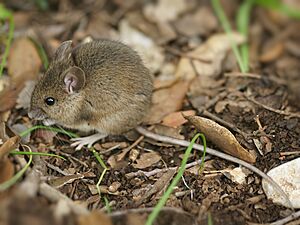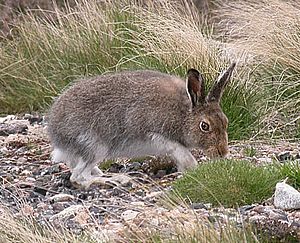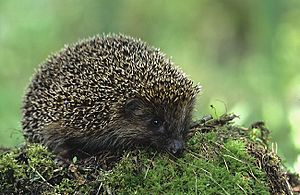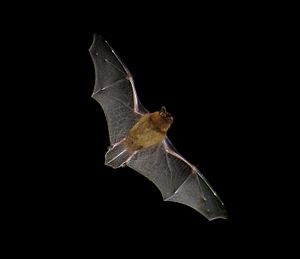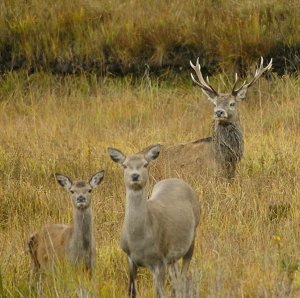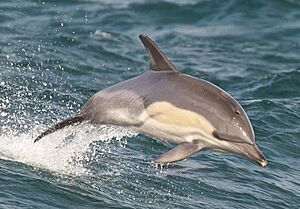List of mammals of Great Britain facts for kids
Great Britain is home to many amazing mammals, but it has fewer types of land mammals compared to mainland Europe. This is because of what happened after the last ice age. A long time ago, Great Britain was connected to Europe by a land bridge. Only animals that crossed this bridge before it was flooded (when the English Channel formed) or those brought by humans live here today.
A "native" species means an animal that has lived in Great Britain for a very long time. This usually means they arrived after the last ice age, about 9,500 years ago, or were here when the English Channel formed around 8,000 years ago. There are no mammal species found only in Great Britain. However, four special types of rodents have developed on smaller islands nearby.
Scientists and conservation groups like Natural England and The Mammal Society keep track of how well mammal populations are doing in Great Britain. They use special categories to show if a species is at risk. Here's what those categories mean:
- Extinct: This means the species has completely disappeared. There are no more living individuals.
- Extinct in the wild: These animals only exist in zoos or in places far from their original homes.
- Critically endangered: This species is in very serious danger of disappearing from the wild soon.
- Endangered: This species faces a very high risk of disappearing from the wild.
- Vulnerable: This species is at a high risk of disappearing from the wild.
- Near threatened: This species isn't currently at high risk, but it might be in the future.
- Least concern: There are no big worries about this species right now.
- Data deficient: We don't have enough information to know if this species is at risk.
Contents
Pouched Mammals (Diprotodonts)
Order: Diprotodontia
Most pouched mammals, like kangaroos and wallabies, live in Australia. But one type, the red-necked wallaby, has been brought to Great Britain. Some groups of these wallabies now live freely in the wild. You can find them on Inchconnachan island in Loch Lomond, Scotland, and on the Isle of Man. Other groups used to live in places like Devon, but they are thought to be gone now, though people still sometimes spot them.
Family: Macropodidae (kangaroos, wallabies, and similar animals)
- Red-necked wallaby, Notamacropus rufogriseus (introduced)
Rodents
Order: Rodentia
Rodents are the largest group of mammals, making up about 40% of all mammal species! They are known for their strong front teeth (incisors) that never stop growing. These teeth help them gnaw on food and build homes. Rodents live almost everywhere on Earth.
Family: Castoridae (beavers)
- Eurasian beaver, Castor fiber (reintroduced)
Family: Cricetidae (hamsters, voles, and similar animals)
- European water vole, Arvicola amphibius (endangered in Great Britain)
- Short-tailed field vole, Microtus agrestis
- Common vole, Microtus arvalis
- Orkney vole, M. a. orcadensis
- Bank vole, Myodes glareolus
Family: Muridae (mice, rats, and similar animals)
- Yellow-necked mouse, Apodemus flavicollis
- Wood mouse, Apodemus sylvaticus
- St Kilda field mouse, A. s. hirtensis
- Eurasian harvest mouse, Micromys minutus
- House mouse, Mus musculus
- St Kilda house mouse, M. m. muralis (extinct around 1930)
- Brown rat, Rattus norvegicus (introduced)
- Black rat, Rattus rattus (introduced)
Family: Gliridae (dormice)
- European edible dormouse, Glis glis (introduced)
- Hazel dormouse, Muscardinus avellanarius (vulnerable in Great Britain)
Family: Sciuridae (squirrels)
- Eastern gray squirrel, Sciurus carolinensis (introduced)
- Red squirrel, Sciurus vulgaris (near threatened in Great Britain)
Hares and Rabbits (Lagomorphs)
Order: Lagomorpha
Lagomorphs include hares, rabbits, and pikas. Even though they might look a bit like rodents, they are a separate group of mammals. One key difference is that lagomorphs have four front teeth in their upper jaw, while rodents only have two.
Family: Leporidae (rabbits and hares)
- European hare, Lepus europaeus (introduced)
- Mountain hare, Lepus timidus
- European rabbit, Oryctolagus cuniculus (introduced)
Insect-Eating Mammals (Eulipotyphlans)
Order: Eulipotyphla
This group includes mammals that mostly eat insects. Hedgehogs are easy to spot with their spiky coats. Shrews look a lot like small mice, while moles are strong burrowers that live underground.
Family: Talpidae (moles)
- European mole, Talpa europaea
Family: Soricidae (shrews)
- Lesser white-toothed shrew, Crocidura suaveolens
- Eurasian water shrew, Neomys fodiens
- Common shrew, Sorex araneus
- Eurasian pygmy shrew, Sorex minutus
Family: Erinaceidae (hedgehogs)
- European hedgehog, Erinaceus europaeus (vulnerable in Great Britain)
Bats
Order: Chiroptera
Bats are truly unique because they are the only mammals that can fly! Their front limbs have developed into wings. Bats make up about 20% of all mammal species on Earth.
Family: Rhinolophidae (horseshoe bats)
- Lesser horseshoe bat, Rhinolophus hipposideros
- Greater horseshoe bat, Rhinonophus ferrumequinum
Family: Vespertilionidae (common bats)
- Western barbastelle, Barbastella barbastellus (vulnerable in Great Britain)
- Serotine bat, Eptesicus serotinus (vulnerable in Great Britain)
- Bechstein's bat, Myotis bechsteini
- Brandt's bat, Myotis brandti
- Daubenton's bat, Myotis daubentoni
- Greater mouse-eared bat, Myotis myotis (possibly no longer in Great Britain)
- Whiskered bat, Myotis mystacinus
- Natterer's bat, Myotis nattereri
- Lesser noctule, Nyctalus leisleri
- Common noctule, Nyctalus noctula
- Nathusius pipistrelle, Pipistrellus nathusii
- Common pipistrelle, Pipistrellus pipistrellus
- Soprano pipistrelle, Pipistrellus pygmaeus
- Brown long-eared bat, Plecotus auritus
- Grey long-eared bat, Plecotus austriacus (vulnerable in Great Britain)
- Parti-coloured bat, Vespertilio murinus
Carnivores
Order: Carnivora
Carnivores are mammals that mostly eat meat. There are over 260 different types of carnivores. They have special teeth and skull shapes that help them hunt and eat their prey.
Family: Canidae (dogs)
- Red fox, Vulpes vulpes
Family: Mustelidae (weasels, badgers, and similar animals)
- Asian small-clawed otter, Aonyx cinereus (introduced)
- Eurasian otter, Lutra lutra
- European pine marten, Martes martes
- European badger, Meles meles
- Stoat, Mustela erminea
- Least weasel, Mustela nivalis
- European polecat, Mustela putorius
- American mink, Neogale vison (introduced)
Family: Felidae (cats)
- European wildcat, Felis silvestris (critically endangered in Great Britain)
- Scottish wildcat, F. s. silvestris
Family: Phocidae (earless seals)
- Grey seal, Halichoerus grypus
- Harbour seal, Phoca vitulina
Hoofed Mammals (Even-toed Ungulates)
Order: Artiodactyla
Even-toed ungulates are hoofed animals that walk on their third and fourth toes. This group includes many animals important to humans, like cattle. Whales and dolphins are also considered part of this group by scientists!
Family: Suidae (pigs)
- Wild boar, Sus scrofa (reintroduced)
Family: Cervidae (deer)
- Roe deer, Capreolus capreolus
- Siberian roe deer, Capreolus pygargus (introduced, no longer in Great Britain)
- Red deer, Cervus elaphus
- Scottish red deer, C. e. scoticus
- Sika deer, Cervus nippon (introduced)
- European fallow deer, Dama dama (introduced)
- Water deer, Hydropotes inermis (introduced)
- Reeves's muntjac, Muntiacus reevesi (introduced)
Family: Bovidae (cattle, bison, and similar animals)
- European bison, Bison bonasus (reintroduced)
Whales and Dolphins (Cetaceans)
Order: Cetacea
This order includes all whales, dolphins, and porpoises. They are mammals that have fully adapted to life in the water. They have smooth, nearly hairless bodies with a thick layer of blubber for warmth. Their front limbs and tails have changed to help them swim underwater.
Family: Balaenidae (right whales)
- North Atlantic right whale, Eubalaena glacialis (possibly still in Great Britain)
Family: Balaenopteridae (rorquals)
- Common minke whale, Balaenoptera acutorostrata
- Sei whale, Balaenoptera borealis
- Blue whale, Balaenoptera musculus
- Fin whale, Balaenoptera physalus
- Humpback whale, Megaptera novaeangliae
Family: Phocoenidae (porpoises)
- Harbour porpoise, Phocoena phocoena (near threatened in Europe)
Family: Physeteridae (sperm whales)
- Sperm whale, Physeter macrocephalus
Family: Kogiidae (pygmy and dwarf sperm whales)
- Pygmy sperm whale, K. breviceps
Family: Ziphiidae (beaked whales)
- Cuvier's beaked whale, Ziphius cavirostris
- Northern bottlenose whale, Hyperoodon ampullatus
- Sowerby's beaked whale, Mesoplodon bidens
- Gervais' beaked whale, Mesoplodon europaeus
- True's beaked whale, Mesoplodon mirus
Family: Delphinidae (oceanic dolphins)
- White-beaked dolphin, Lagenorhynchus albirostris
- Atlantic white-sided dolphin, Lagenorhynchus acutus
- False killer whale, Pseudorca crassidens
- Common dolphin, Delphinus delphis
- Common bottlenose dolphin, Tursiops truncatus
- Striped dolphin, Stenella coeruleoalba
- Risso's dolphin, Grampus griseus
- Orca, Orcinus orca
Mammals No Longer Found in Great Britain
These mammals used to live in Great Britain but are now "locally extinct," meaning they are gone from this area, even if they still live elsewhere in the world.
- Eurasian elk, Alces alces
- Grey wolf, Canis lupus
- Wolverine, Gulo gulo
- Eurasian lynx, Lynx lynx
- Reindeer, Rangifer tarandus
- Brown bear, Ursus arctos
See also
- Biota of the Isle of Man
- List of endemic species of the British Isles
- List of extinct animals of the British Isles
- List of mammals of Ireland


